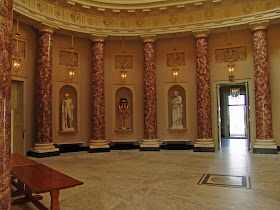Half way around our tour of Stowe we came upon the House. It is one of the World Monument Fund's most endangered buildings. Between 2002 and 2012 over 40 million GBP had been spent on restoring the house.

Above and Below: The South facade of Stowe House. The facade stretches for over 460 feet. The columns on the central section of the house are 35 feet tall.
The lions are the original lead Medici lions, which were sold in 1921 and located to Stanley Park, Blackpool. There were replaced by more Egyptian-looking stone lions for a time, but thanks to some serious fund raising the original lions were repurchased, reconditioned and placed back on their plinths where they belong just 5 months before we visited!
Below: The figures of Liberty and Religion atop the west pavilion.
Below: Two figures of the four seasons represented in the tympanum above the tripartite windows on either side of the portico.
Above: The steps up to the front entrance, which opens into the marble saloon (below). It was designed to be an elliptical version of the Pantheon.
Above and Below: Two 'Sneaky' photos of the inside of the house. Unfortunately the house was shut the day we arrived, but the door was open... The floor is made of 72 four foot slabs of Carrara marble.
Above: An elaborate frieze portraying 280 human figures and 14 animals, mainly horses in the Suovetaurillia (the annual sacrifice of a pig, sheep and bull to the god Mars in order to gain his blessing on the land).
Below: The coffered ceiling, made of 160 individually shaped coffers, supporting an elliptical window in the centre.
(Above photo courtesy of Wikipedia)
Above and Below: The doric columns formed from red scagliola, mimicking Sicilian jasper, with white marble bases and capitols.
Below: The view over the south lawn back to the Octagon lake and beyond to the Corinthian Arch.
The next stop on our perambulations was the Temple of Concord and Victory...

This was only restored to its former grandeur in 1996. Prior to then it was missing 16 columns which had been removed in 1926 for construction of the school's chapel. The roof and facade were also in disrepair. New columns were carved and the roof was repaired at a cost of 1.3 millions GBP!
Above: View of the peristyle ceiling.
Below: View of the pronaos ceiling and door.
Below: The interior of the temple with an aedicule containing a statue of Liberty.
It was the largest of the garden buildings, the designer unknown but thought to be either Earl Temple or Thomas Pitt.
Above: Peter standing on the parapets of the steps looking out over the Grecian Valley (view below), an L-shaped valley covering 60 acres.
The valley was dug out by hand and required the removal of 23,500 cubic yards of earth by barrow! It was originally meant to be flooded, however that was not possible, so it was left pretty much as it is today...
Above and Below: A view back to the temple down the Grecian Valley.
Below: The Wolfe Obelisk. It stands 100 feet tall and commemorates General James Wolfe, remembered for his victory over the French in the Battle of Quebec.

On our travels from the Temple heading East we passed the Fane (pagan temple) of Pastoral Poetry. It is a small belvedere, designed by James Gibbs in 1729.
Below: One of the four herms that abut the chamfered corners.
Below: Peter taking a rest and consulting the map.



























What a lovely day and beautiful photographs. Such a shame the house was closed. Although I'm sure you could spend days just wandering through the gardens.
ReplyDelete